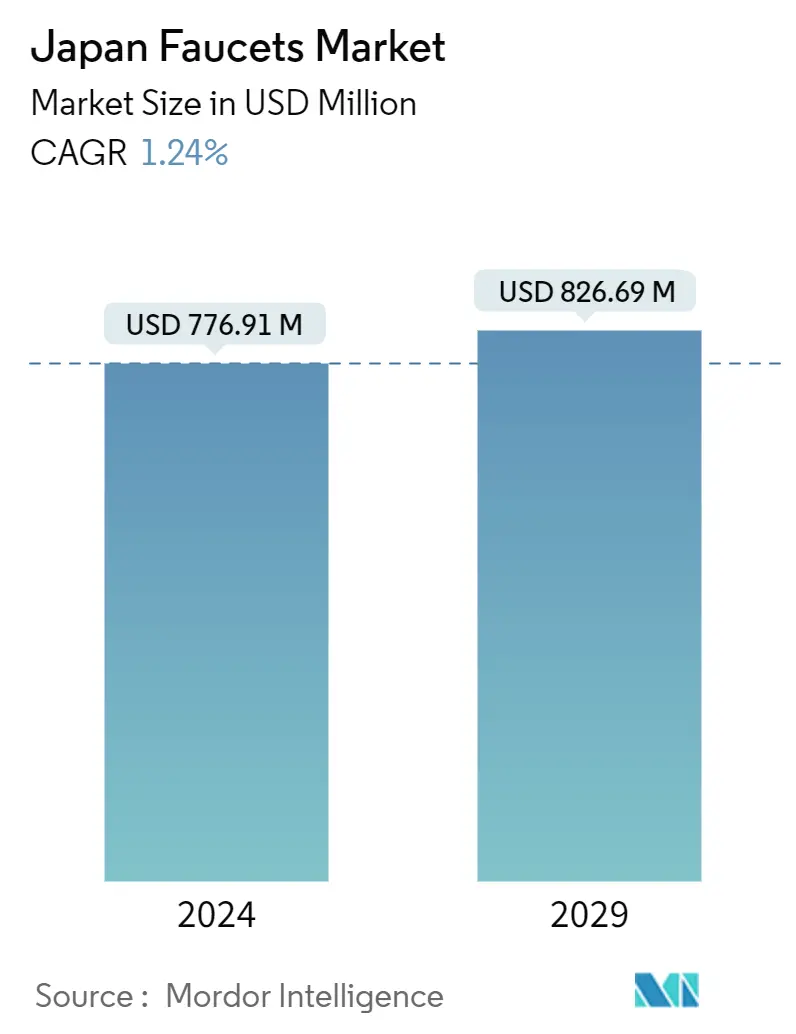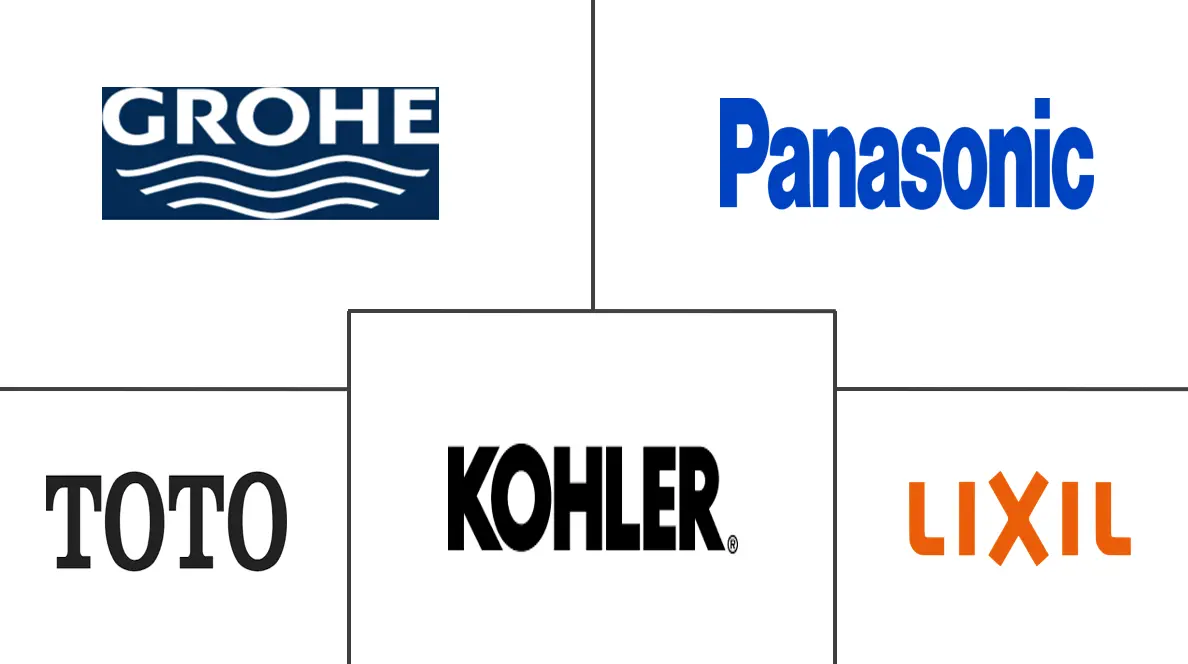Market Size of Japan Faucets Industry

| Study Period | 2020 - 2029 |
| Base Year For Estimation | 2023 |
| Market Size (2024) | USD 776.91 Million |
| Market Size (2029) | USD 826.69 Million |
| CAGR (2024 - 2029) | 1.24 % |
| Market Concentration | Low |
Major Players
*Disclaimer: Major Players sorted in no particular order |
Japan Faucets Market Analysis
The Japan Faucets Market size is estimated at USD 776.91 million in 2024, and is expected to reach USD 826.69 million by 2029, growing at a CAGR of 1.24% during the forecast period (2024-2029).
The Japanese faucets market in is a thriving industry that has witnessed steady growth over the years. Japan strongly emphasizes quality, innovation, and water conservation and has become a hub for advanced faucet technologies. One of the key drivers of the market is the construction and renovation sector. Japan has a robust construction industry, constantly demanding faucets in residential, commercial, and infrastructure projects. The need for new installations, replacements, and upgrades fuels this demand. The shifting preferences and lifestyles of consumers have an impact on the market as well. The need for durable, practical, and visually beautiful faucets has grown because of urbanization and industrialization. Modern features, eco-friendly materials, and elegant designs are what Japanese consumers look for in faucets.
With water conservation being a priority in Japan due to the country's limited water resources, there is a strong emphasis on faucets designed to minimize water wastage. This includes the development of faucets with low flow rates and sensors that control water usage more efficiently. Japan has strict environmental regulations governing water usage and product standards. Faucet manufacturers must comply with these regulations, often driving innovation in water-saving technologies and eco-friendly materials.
Japan Faucets Industry Segmentation
A faucet is a kind of plumbing fixture where a knob, valve, or orifice controls the water flow. The components of a tap include the handle, the cartridge, the spout, the aerator, the mixing chamber, and the water inlets. The Japanese faucets market is segmented by product type, technology, material used, application, and end-user. By product type, the market is segmented into ball, disc, cartridge, and compression. By technology, the market is segmented into manual and automatic. By material used, the market is segmented into stainless steel, bronze, plastic, and other materials used (copper and zinc). By application, the market is segmented into bathroom and kitchen. By end user, the market is segmented into residential and commercial. The report offers the market size for the Japanese faucets market in value terms in USD for all the abovementioned segments.
| By Product Type | |
| Ball | |
| Disc | |
| Cartridge | |
| Compression |
| By Technology | |
| Manual | |
| Automatic |
| By Material Used | |
| Chrome | |
| Stainless Steel | |
| Brass | |
| Polytetra Methylene Terephthalate (PTMT) Plastic | |
| Other Materials |
| By Application | |
| Bathroom Faucets | |
| Kitchen Faucets |
| By End User | |
| Residential | |
| Commercial |
| By Installation Type | |
| Wall Mount | |
| Deck Mount |
Japan Faucets Market Size Summary
The Japanese faucets market is a dynamic and evolving industry, characterized by a strong focus on quality, innovation, and sustainability. The market is significantly influenced by the construction and renovation sector, which drives demand for new installations, replacements, and upgrades in residential, commercial, and infrastructure projects. As urbanization and industrialization continue to shape consumer preferences, there is an increasing demand for faucets that are not only durable and practical but also aesthetically pleasing. Japanese consumers prioritize modern features, eco-friendly materials, and elegant designs, aligning with the country's commitment to water conservation and environmental sustainability. The market is also shaped by stringent environmental regulations that encourage manufacturers to innovate in water-saving technologies and eco-friendly product offerings.
Technological advancements have played a crucial role in the Japanese faucets market, introducing features that enhance functionality, convenience, and sustainability. Innovations such as touchless operation and sensor-activated faucets have gained popularity, particularly in public restrooms and homes, by promoting hygiene and reducing cross-contamination. Water conservation technologies, including flow restrictors, aerators, and smart water-saving systems, align with Japan's environmental goals and help consumers reduce water consumption. The market is competitive, with key players like TOTO, LIXIL Group, Panasonic, Grohe, and Kohler investing in product innovation and expanding distribution channels to meet growing demand. Ongoing research and development are expected to yield even more advanced and efficient faucet options, further driving the market's growth.
Japan Faucets Market Size - Table of Contents
-
1. MARKET DYNAMICS AND INSIGHTS
-
1.1 Market Overview
-
1.2 Market Drivers
-
1.2.1 Rising Construction and Renovation Activities
-
1.2.2 Increasing Awareness of Water Conservation and Sustainability
-
-
1.3 Market Restraints
-
1.3.1 High Cost Associated with Smart Faucets Solutions
-
1.3.2 Intense Competition among Domestic and International Manufacturers
-
-
1.4 Market Opportunities
-
1.4.1 Adoption of Smart Faucets
-
1.4.2 Collaborations with Construction Companies and Architects
-
-
1.5 Value Chain Analysis
-
1.6 Industry Attractiveness: Porter's Five Forces Analysis
-
1.6.1 Threat of New Entrants
-
1.6.2 Bargaining Power of Buyers
-
1.6.3 Bargaining Power of Suppliers
-
1.6.4 Threat of Substitutes
-
1.6.5 Intensity of Competitive Rivalry
-
-
1.7 Insights into Technological Advancements in the Industry
-
1.8 Impact of COVID-19 on the Market
-
-
2. MARKET SEGMENTATION
-
2.1 By Product Type
-
2.1.1 Ball
-
2.1.2 Disc
-
2.1.3 Cartridge
-
2.1.4 Compression
-
-
2.2 By Technology
-
2.2.1 Manual
-
2.2.2 Automatic
-
-
2.3 By Material Used
-
2.3.1 Chrome
-
2.3.2 Stainless Steel
-
2.3.3 Brass
-
2.3.4 Polytetra Methylene Terephthalate (PTMT) Plastic
-
2.3.5 Other Materials
-
-
2.4 By Application
-
2.4.1 Bathroom Faucets
-
2.4.2 Kitchen Faucets
-
-
2.5 By End User
-
2.5.1 Residential
-
2.5.2 Commercial
-
-
2.6 By Installation Type
-
2.6.1 Wall Mount
-
2.6.2 Deck Mount
-
-
Japan Faucets Market Size FAQs
How big is the Japan Faucets Market?
The Japan Faucets Market size is expected to reach USD 776.91 million in 2024 and grow at a CAGR of 1.24% to reach USD 826.69 million by 2029.
What is the current Japan Faucets Market size?
In 2024, the Japan Faucets Market size is expected to reach USD 776.91 million.

